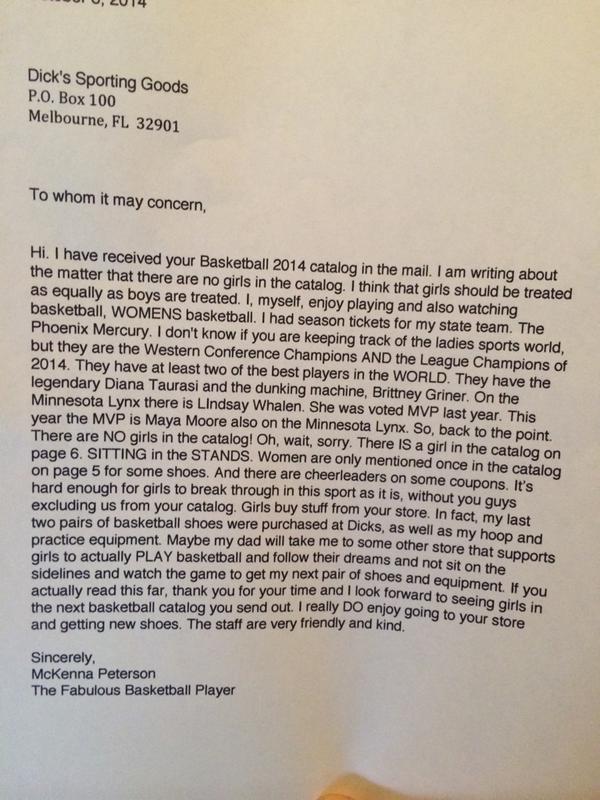 In mid-October, 12-year-old McKenna Peterson of Arizona
gained national fame when a story broke describing a letter she wrote to Dick’s
Sporting Goods regarding the dearth of women appearing in Dick’s basketball
catalog. In fact, she noted that the
only woman who appeared in the catalog at all was a photo of one sitting in the
stands at a basketball game, but the catalog did include some cheerleaders on its coupons. In her letter, she calls
herself an avid basketball player, as well as a big fan of the reigning WNBA
Champion Phoenix Mercury, and openly questions whether she should take her
business to a sporting goods store that “supports girls to actually PLAY
basketball and follow their dreams and not sit on the sidelines.”
In mid-October, 12-year-old McKenna Peterson of Arizona
gained national fame when a story broke describing a letter she wrote to Dick’s
Sporting Goods regarding the dearth of women appearing in Dick’s basketball
catalog. In fact, she noted that the
only woman who appeared in the catalog at all was a photo of one sitting in the
stands at a basketball game, but the catalog did include some cheerleaders on its coupons. In her letter, she calls
herself an avid basketball player, as well as a big fan of the reigning WNBA
Champion Phoenix Mercury, and openly questions whether she should take her
business to a sporting goods store that “supports girls to actually PLAY
basketball and follow their dreams and not sit on the sidelines.”
In one letter, this young girl brought to light the
chicken-or-egg question that has regularly plagued women’s sports – both on the
collegiate and professional levels – for the past several years.
The question: How do
we grow the popularity of women’s sports?
Will popularity be driven by television and sponsors? Or will increased player participation and
fan demand force TV and sponsors to hop on board?
From a participation standpoint, women’s sports appear to be
doing quite well. The number of girls
participating in high school sports is at an all-time high and continues
to grow year after year. At the
collegiate level, participation in women’s sports across the NCAA’s three
divisions has grown from nearly 158,000 in 2000-01 to nearly
204,000 in 2012-13.
Women’s sports are also currently witnessing an uptick in
fan popularity, and not just in tennis, which has long been the most
popular women’s sport. The 2014 NCAA
Women’s Basketball final between unbeatens UConn and Notre Dame earned ESPN
its highest rating for a women’s basketball game since 2004. And TV ratings for the WNBA are on the rise
as well after hitting their nadir in 2012, though the league’s ratings still
lag behind those of women’s college basketball.
The good news is that television seems be doing its
part. ESPN and its vast array of
networks will televise 131 women’s college basketball games, resulting
in record coverage. ESPN networks
also annually televise women’s soccer, softball and volleyball. Young girls are able to turn on the TV and
can be inspired to get involved in almost any sport out there.
However, for the most part, media attention/coverage of
women’s sports is reserved for only the most astounding of feats. While all the aforementioned sports are
televised, they rarely find their way onto highlight shows or newscasts. Often, the only times that girls get
widespread media coverage is when they play with the boys, as in the case of
Danica Patrick, Michelle Wie, or most recently, young Mo’ne Davis. Otherwise, individual female athletes who
gain national notoriety continue to be confined to professional tennis, aside
from the occasional athlete who gains fame during an Olympic year.
Similarly, sponsors seem to be lagging behind. Televised women’s sports currently draw
relatively small ratings, and therefore hold relatively little value for
potential sponsors. In fact, as
Peterson’s letter to Dick’s shows, some businesses (mistakenly or otherwise)
neglect to appeal to women and girls at all.
It’s completely understandable in this era of tighter budgets that
companies involved in sports want to focus on those that provide the most
reliable returns on their investments.
At some point, the double standard that women’s sports face
will change, but the chicken-or-egg question as to what will drive that change
remains. Female athletes obviously
shouldn’t have to be held to the standard of whether they can compete with
their male counterparts in order to be appreciated and celebrated, and the
media should be held accountable to ensure that the Brittney Griners of the
world are celebrated for the same reasons as the Kevin Durants: because they’re
the best at what they do. Additionally,
as long as participation at the high school and collegiate levels continue to
rise and popularity of women’s sports continues to grow, it follows that demand
for increased television coverage will rise, and sponsors will hopefully come
out of the woodwork. The on-court
playing field for female athletes has been steadily leveling over the past
decade. The next step is to level the
playing field off the court as well.


Lions vs Packers live Stream
ReplyDeletePackers vs lions live Stream
Lions vs Packers live
Packers vs lions live
Green Bay Packers vs Detroit Lions Live Stream
Detroit Lions vs Green Bay Packers Live Stream
Green Bay Packers vs Detroit Lions Live
Detroit Lions vs Green Bay Packers Live